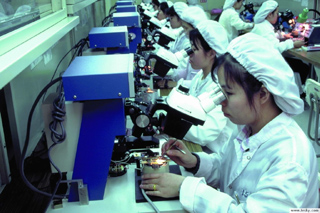
 China Tours
China Tours Tibet Tours
Tibet Tours China Theme Tours
China Theme Tours Off The Beaten Track
Off The Beaten Track Yangtze Cruises
Yangtze Cruises China Trip Planner
China Trip Planner Travel Agents
Travel Agents


We had a wonderful time in Tibet. We have learned a lot about this unique destination because of the wonderful guide Degyi who is so knowledge and always available towards our tours. We stayed at the Shangri-La Hotel Lhasa, and we would never imagine a Tibet travel could be so nice and amazing without the help of Degyi.
Also, thanks a lot to our Tibetan driver Mr.Wongdun for his safe driving and a good sense of service along the way.
We shall return Tibet in the near future!
P.B. and A. A - Europe
Tibet Travel
June 2018 (Private Tibet Journey from Kathmandu)

 After decades of chaos and wars, China's industry had very little to start with before 1949. Most finished industrial products were imported at that time. After the founding of New China in 1949, the Chinese government started construction on a large and planned scale. As a result, the country's industrial foundation has been strengthened and its production level raised rapidly. The metallurgical, mining and energy industries, airplane and automobile industries, and the new industries, including petrochemicals, computers, telecommunication equipment, instruments and meters, and aeronautics have been built up from nothing.
After decades of chaos and wars, China's industry had very little to start with before 1949. Most finished industrial products were imported at that time. After the founding of New China in 1949, the Chinese government started construction on a large and planned scale. As a result, the country's industrial foundation has been strengthened and its production level raised rapidly. The metallurgical, mining and energy industries, airplane and automobile industries, and the new industries, including petrochemicals, computers, telecommunication equipment, instruments and meters, and aeronautics have been built up from nothing. Since 1978, the policies of reform and opening to the outside world have enabled China's industry to enter a stage of great innovation and development. From 1978 to 1999, China's industry increased at an average rate of 11.1 percent every year, and the comprehensive industrial strength was remarkably enhanced. By 1999, some 3,535.7 billion Yuan of industrial added value had been attained, an increase of 10.2 times over 1978. China's industrial reform first began by giving more rights to and leaving more profits for enterprises, extending enterprises' independent operations and practicing the enterprise contract responsibility system, which fully mobilized the initiative and creativeness of enterprises and their workers and staff members, and created an excellent environment for the improvement of the operation mechanism of enterprises.
Next, China speeded up its industrialization through the introduction of foreign capital and opening to the outside world. The establishment of large numbers of Sino-foreign joint and wholly foreign-owned enterprises has not only brought more capital to enterprises, but also advanced equipment and modernized management. Through 21 years of reform, China's industry has got rid of the backwardness in which it could only make one or a few varieties of products and its technological level was low.
The reform of state industrial enterprises, especially large and medium-sized enterprises, is the constant focus of China's economic system reform. Before 1978, state-owned and collectively-owned enterprises represented 77.6 percent and 22.4 percent respectively of China's exclusively public-ownership economy. The policy of reform and opening-up has given extensive scope to the common development of various economic sectors. Individual and private industrial enterprises and enterprises with foreign, Hong Kong, Macao or Taiwan investments have mushroomed.
Reform of state-owned enterprises has always been the key link of China's economic restructuring.
The Chinese government has made various attempts to solve the problem of chronic extensive losses in this sector and by now almost every state-owned enterprise has adopted the company system. After being transformed into joint stock companies, the economic benefit of the state-owned enterprises increased steadily and their overall strength and quality were remarkably enhanced, gaining continuously in their control, influence and lead in the whole national economy. In 2004, of the industrial added value created by all state-owned industrial enterprises and non-state industrial enterprises with annual turnover exceeding five million Yuan, state-owned and state stock-holding enterprises accounted for 42.4 percent, collectively-owned enterprises 5.3 percent, the rest taken up by other non-public enterprises, including enterprises with foreign, Hong Kong, Macao or Taiwan investments, and individual and private enterprises. The result is a dynamic juxtaposition of diversified economic elements.
China Trip Planner | Travel Agents | About Us | Why Us | Contact Us | How to Pay | How to Book - Terms & Conditions | Site Map
Copyright © 2010 - 2030 All Rights Reserved.


 0086-28-85711328
0086-28-85711328 0086-28-85546015
0086-28-85546015




